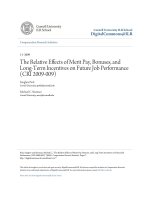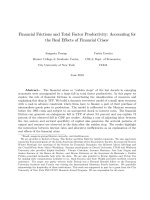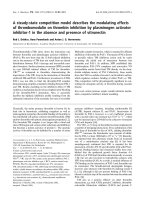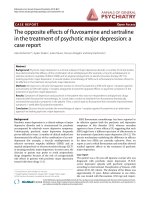Investigating the cultivation effects of television advertisements and agricultural knowledge gaps on college students’ perceptions of modern dairy husbandry practices
Bạn đang xem bản rút gọn của tài liệu. Xem và tải ngay bản đầy đủ của tài liệu tại đây (960.25 KB, 137 trang )
Investigating the Cultivation Effects of Television Advertisements and Agricultural
Knowledge Gaps on College Students’ Perceptions of Modern Dairy Husbandry Practices
Thesis
Presented in Partial Fulfillment of the Requirements for the Degree Master of Science in
the Graduate School of The Ohio State University
By
Annie Ruth Specht, B.S., B.A.
Graduate Program in Agricultural & Extension Education
The Ohio State University
2010
Thesis Committee:
Emily B. Rhoades, Advisor
M. Susie Whittington
Copyrighted by
Annie Ruth Specht
2010
Abstract
The unrealistic images of American agricultural practices generated by commodity
television advertising, coupled with a dearth of agricultural knowledge in modern society,
may promote misunderstandings of modern agriculture based on cultivation and
knowledge-gap theory. This study investigated the possible effects of the “Happy Cows
Come from California” television campaign on college students’ perceptions of dairy
husbandry practices, compared affective responses to those advertisements to fact-based
video content, and correlated these responses with agricultural awareness and television
consumption habits. No significant relationship between perceptions of dairy farm
practices, awareness, and TV consumption was found, but participants reported a more
positive response to the informational videos. The researchers recommend a movement
away from purely entertaining advertising content for agricultural products in favor of
more realistic, fact-based promotions.
ii
Dedication
This work is dedicated to a proud farm family.
iii
Acknowledgements
The author would like to thank her advisor, Dr. Emily Rhoades, and Dr. Susie
Whittington for their wisdom and support. Thanks also go to the rest of her Buckeye
family in the Department of Human & Community Resource Development. They have
been an instrumental and invaluable part of the research process.
iv
Vita
May 2004 ………………………..………… Dover High School
June 2008 ……………………………….…. B.S. Agriculture, B.A. Humanities,
Magna Cum Laude,
The Ohio State University
September 2009 to present ………………… Graduate Teaching Associate, Department
of Human & Community Resource
Development, The Ohio State University
August 2010 ……………………………….. M.S. Agriculture, The Ohio State University
Fields of Study
Major Field: Agricultural & Extension Education, Agricultural Communication
v
Table of Contents
Abstract ............................................................................................................................... ii
Dedication .......................................................................................................................... iii
Acknowledgements ............................................................................................................ iv
Vita ...................................................................................................................................... v
List of Tables ..................................................................................................................... vii
List of Figures .................................................................................................................. viii
Chapter 1: Introduction ....................................................................................................... 1
Chapter 2: Review of the Literature .................................................................................. 22
Chapter 3: Methodology.................................................................................................... 50
Chapter 4: Results ............................................................................................................. 60
Chapter 5: Conclusions and Recommendations ................................................................ 81
References ......................................................................................................................... 96
Appendix A: Survey Instrument ..................................................................................... 112
Appendix B: IRB Materials............................................................................................. 122
vi
List of Tables
Table 1. A categorization of advertising uses and gratifications ...................................... 46
Table 2. Sample questionnaire items for uses and gratifications ...................................... 54
Table 3. Sample questionnaire items for advertising uses and gratifications ................... 54
Table 4. Percent of content viewed by platform ............................................................... 64
Table 5. Uses of television viewership.............................................................................. 64
Table 6. Uses of advertising viewership ........................................................................... 65
Table 7. Descriptive statistics for “Happy Cows”............................................................. 71
Table 8. Descriptive statistics for farm-tour videos .......................................................... 73
Table 9. T-test for differences in scale results .................................................................. 73
Table 10. Correlations between awareness and “Happy Cows” characteristics ............... 77
Table 11. Correlations between awareness and farm-tour video characteristics .............. 78
Table 12. Correlations between hometown and farm-tour video characteristics .............. 78
Table 13. Correlations between TV viewership and “Happy Cows” characteristics ........ 79
Table 14. Correlations between TV viewership and farm-tour video characteristics ....... 79
Table 15. Correlations between advertising uses and “Happy Cows” characteristics ...... 77
vii
List of Figures
Figure 1. Frequency of respondent hometown types ........................................................ 61
Figure 2. Frequency of respondent academic programs by college .................................. 62
Figure 3. Respondent television viewing in hours per day ............................................... 63
Figure 4. Respondent agricultural knowledge................................................................... 66
Figure 5. Respondent agricultural awareness .................................................................... 67
Figure 6. Respondent agricultural familiarity ................................................................... 67
Figure 7. Importance of agriculture to respondents .......................................................... 68
Figure 8. Frequency of respondent visits to farm or agricultural operation ...................... 69
Figure 9. Frequency of respondent work on farm or agricultural operation ..................... 69
Figure 10. Frequency of respondent attendance at fair or agricultural event .................... 70
Figure 11. Frequency of respondent interaction with agriculturalists ............................... 70
Figure 12. Respondents’ choice for most accurate portrayal of dairy practices ............... 75
Figure 13. Respondents’ choice for portrayal of preferred dairy practices ....................... 75
viii
Chapter 1: Introduction
In November 2008, California voters overwhelmingly passed the “Standards for
Confining Farm Animals” initiative, or Proposition (“Prop”) 2, a piece of legislation that
restricts the use of animal husbandry tools such as veal and sow gestation crates and
battery cages for hens (Goll, 2008). Prop 2 was backed with financial and grassrootsmembership support from the Humane Society of the United States (HSUS), an animalwelfare lobbying organization that had successfully instituted ballot initiatives in several
other states (Birnbaum, 2007).
Encouraged by HSUS’s media campaign, a majority of voters in California, which
is the sixth-largest egg-producing state in the nation, passed the initiative despite
warnings that “a potential ban on battery cages could be…disruptive to California's egg
industry” (“HSUS lands,” 2008, p. 35). Such a ban could cause egg prices to rise and thus
increase outsourcing of poultry production to other states and countries such as Mexico,
where food-quality standards are notoriously low (Schmit, 2008). The tactics utilized by
agricultural organizations and commodity groups to raise concerns about food security
and rising prices were no match for the images of injured chickens packed four-deep into
small cages and veal calves struggling against short tethers collected by the Humane
Society of the United States and disseminated across television screens and on the World
Wide Web.
1
These photographs and videos were all the more damaging to agriculture’s image
because they violated long-held societal perceptions of the industry and how it functions
(Fraser, 2001; Wachenheim & Rathge, 2000). The modern operation—with its reliance
on science and technology—hardly resembles the pastoral ideal proliferated by a growing
disconnect between agricultural producers and consumers (Holloway, 2004). This gulf
between agriculture’s reality and America’s farm fantasy bears investigation: Who (or
what) is responsible for the public’s expectations of agriculture and for propagating the
“American agrarian ideal” (Fraser, 2001)?
Cultivation Theory
One possibility lies in an oft-cited theory (Gerbner, Gross, Morgan, & Signorielli,
1994): cultivation. Cultivation theory was introduced as opposition to the one-shot
“hypodermic needle” or “magic bullet” theories of media effects that resulted from
propaganda studies in the 1930s (Shanahan & Morgan, 1999). Its principle authors used
the term “cultivation” to build on “the assumption that the major impacts of television
materialize by means of the way it exposes people to the same images and metaphors
over and over again” (Shanahan & Morgan, 1999, p. 12).
Heavy television viewers, cultivation theorists argue, will find that television
replaces other sources of information, reinforcing the idea that the real world is similar to
the world portrayed on television and thus influencing both attitudes and behavior
(Shrum, Wyer, & O’Guinn, 1998; Gerbner, et al., 1994). Several characteristics of
television contribute to its ability to cultivate certain world-views. It is ubiquitous—most
households boast at least one television set, and viewers watch 151 hours of television
content every month, or more than five hours each day (Gandossy, 2009) —and its
2
effects are invisible. Television is capable of revealing to audiences unfamiliar images,
accounts, and stories of life, and it is largely homogenous, with highly stylized and
formulaic content. Perhaps most significant to this argument, television presents a reality
that is discrepant from “objective reality” but not disparate enough to be dissonant. This
blurring effect “is very significant because consumers may passively accept as real those
television representations that are somewhat, or even significantly, skewed” (O’Guinn &
Shrum, 1997, p. 279).
The acceptance of this reality as truth could have major societal consequences.
Gerbner and his colleagues suggest that heavy viewers of violent television “may begin
to believe that the world is as mean and dangerous in real life as it appears on television,”
a phenomenon called “mean world syndrome” (Murray, 1995, p. 9; Gerbner, Morgan, &
Signorielli, 1993). Studies have shown that regular viewers of crime dramas tend to
overstate the number of Americans employed in law enforcement, and television
viewership may contribute heavily to identity formation and expectations of social norms,
such as gender roles (Harris, 2004). Research exploring cultivation’s influence on
perceptions of agrarian reality, however, has been largely neglected.
Television Advertising and Visual Imagery
Only a small percentage of television programming is devoted to agriculture or
related professions (Harris, 2004), which begs the question: With little opportunity for
exposure to agricultural content, how can audiences form perceptions of the industry?
The researchers posit that the answer may lie not in television programming, but in its
advertisements. The effects of television advertising on issues like perceived violence,
female body image, and product sales have been studied extensively since the early 1980s
3
(Moschis & Moore, 1982; Lodish, Abraham, Livelsberger, Lubetkin, Richardson, &
Stevens, 1995; Botta, 1999). One may reasonably assume that, lacking other sources of
agricultural knowledge, audiences will turn to the limited resources available, including
televised commercial advertisements.
One aspect of television advertising that contributes to attitude formation is visual
imagery. Many scholars theorize that visual communication in advertising impacts the
way people perceive reality. While many agree that advertising images are often
unrealistic, it must be noted that advertising “does not claim to picture reality as it is but
reality as it should be” (Richins, 1991, p. 71; Schudson, 1984). While television
represents homogeneity of thoughts, ideas, and information, advertising “is a force
toward the homogenization of imagery” (Gamson, Croteau, Hoynes, & Sasson, 1992).
Advertising imagery influences attitudinal and behavioral judgments because
information processed with a combination of images and semantics comes to mind most
readily when making judgments (Bone & Ellen, 1992). Bone and Ellen identified two
aspects of media imagery that stimulate processing: focal character and plausibility. The
impact of an advertisement’s focal character is theoretically greatest when the audience
perceives some level of self-relation to that character, making the image more vivid and
more likely to be processed and stored (Bone & Ellen, 1992). Plausibility refers to the
extent to which the audience perceives the image’s context as realistic; the less dissonant
the situation, the more evocative.
The anthropomorphism or humanization of animals, too, plays a part in
advertising; as Lerner and Kalof (1999) note, “animals are of substantial symbolic
importance in human society” (p. 565). Anthropomorphized creatures exhibit human
4
behavior, such as wearing clothes; and humanized characters act like animals but possess
human attributes like speech and cognitive thought (Lerner & Kalof, 1999). Aggarwal
and McGill (2007) posit that anthropomorphism works most effectively through a system
of schema congruity: Humanizing non-human figures is most effective when their
characteristics fit neatly into the audience’s contextual schema, or frameworks of
cognitive knowledge that represent information about topics, concepts, or particular
stimuli, such as their attributes and the relations among those attributes (Aggarwal &
McGill, 2007; Fiske & Linville, 1980). Schema come equipped with networks of
associations that allow inferences to be made based on little substantive information, and
many people have difficulty distinguishing between inferred and observed information in
cases where schema are well-developed (Crockett, 1988). Schema can be both facilitated
and constrained by belief systems, which aid in processing, storing, and organizing
information acquired from the social environment (Allen, Dawson, & Brown, 1989).
Knowledge Gap Theory
Another contributing factor is the growing information divide between farmers
and consumers. According to Tichenor and his colleagues, so-called “knowledge gaps”
are created when mass media information into a social system increases and segments of
the population with higher socioeconomic status acquire information faster than those of
lower socioeconomic status (Ettema, Brown, & Luepker, 1983; Tichenor, Donohue, &
Olien, 1970). While socioeconomic status is considered the primary variable in
knowledge-gap-development studies, other factors, such as audience motivation, may
contribute to the formation of informational divides among social groups (Ettema &
Kline, 1977).
5
Knowledge gap theory is pertinent to the study of social perceptions of agriculture
due to the dwindling farming population and increasing generational movement away
from subsistence agriculture. In 2007, 993,881 American farm operators reported that
farming was their primary source of employment, the second-lowest total in a thirty-year
span (USDA, 2009a). The average age of farmers has been on a steady climb over that
same time period, according to United States Department of Agriculture census data: In
1978, principal farm operators averaged 50.3 years of age; in 2007, that number had risen
to 57.1 (USDA, 2009a). The statistics indicate that fewer young people are becoming
actively involved in production agriculture, contributing to a lack of knowledge in the
general population as well as a potential dearth of motivation to attend to agricultural
information.
Public Perceptions of Rural Life and Agriculture
Rural life in the United States is often described in conservative, almost religious
terms. According to a survey conducted by the W.K. Kellogg Foundation and Greenburg
Quinlan Rosner Research, the nation’s public views rural America as “a series of
dichotomies”: “Rural life represents traditional American values, but is behind the times;
rural life is more relaxed and slower than city life, but harder and more grueling; rural life
is friendly, but intolerant of outsiders and difference; and rural life is richer in community
life, but epitomized by individuals struggling independently to make ends meet”
(Kellogg, 2002, p. 1). The Kellogg researchers also indicate that Americans perceive that
rural America is “serene and beautiful, populated by animals and livestock and landscape
covered by trees and family farms” (Kellogg, 2002, p. 1).
6
Agriculture is often identified as the number-one industry in rural communities,
though only 11.5 percent of rural Americans are employed in the agricultural industry,
and many identify the economic hardships of farming as the primary economic concern
of rural workers (Kellogg, 2002). Eight percent of respondents in the Kellogg study
identified the “decline of the family farm” as a problem faced by rural communities,
citing the loss of the “traditional American values the family farmer exemplifies”
(Kellogg, 2002, p. 11). In a similar vein, study participants also responded negatively to
prompts about large-scale corporate farming: “Respondents see corporate farms as
putting family farmers out of business, mainly by taking over their businesses and
purchasing their land” (Kellogg, 2002, p. 13).
Those perceptions of rural life and agriculture may have been influenced by
coverage of rural America by the mass media. In a 2004 content analysis of television
programming and prominent metropolitan and national-market newspapers, the Kellogg
Foundation identified three distinct news frames, or conceptual frameworks utilized to
organize a story’s information, found in coverage of rural issues. The first frame “linked
‘rural’ with an agricultural or farmstead lifestyle” (Kellogg, 2004, p. 25). The second
frame identifies rural inhabitants as “losers” or “hillbillies” living in impoverished or
backwards conditions. The final theme identified by the Kellogg study was the abstract,
symbol-laden ideology of rural America as “an idealized past as expressed in Norman
Rockewell paintings, Currier & Ives prints and Garrison Keiller’s stories of Lake
Wobegon” (Kellogg, 2004, p. 25). These frames, though existing in varying degrees, are
inherent in most media coverage of rural communities and their concerns.
7
Farming Through the Reality Television Lens
Reality television has proved to be “an entertainment genre of contemporary
cultural debate” (Ruth, Lundy, & Park, 2005, p. 22) as the images that it “purports to
depict accurately...affect how our society experiences and reacts to the subject of a text”
(Joniak, 2001, p. 5; Ruth et al., 2005). This characteristic of reality television is especially
troubling given that this variety of programming has been accused of “breaking cultural
rules…by shifting our conceptions of what is acceptable, by transforming the bases for
cultural judgment” (Abt & Seesholtz, 1994, p. 171; Ruth et al., 2005). The subsequent
inclusion of agriculture-themed reality shows on primetime networks has raised questions
about the possible effects of such media exposure on the industry (Ruth, Lundy, & Park,
2005).
One reality show that garnered widespread attention was for its depiction of
agriculture and rural living is The Simple Life, a 20th Century Fox program that first aired
in December 2003. Touted as a “reality sitcom” based on Green Acres, the program in its
first season followed hotel-heiress and socialite Paris Hilton and childhood friend Nicole
Richie as they experienced life on a small family farm in rural Altus, Arkansas—a
concept developed by Fox’s comedy department, who “wanted to see stilettos in cow
shit” (Ryan, 2003, para. 12; Rogers, 2003). The show received record-high ratings for a
Fox program with 13 million viewers tuning in to its premiere episode and even more
viewing the season’s second episode (Rogers, 2003; Ruth et al., 2005).
The instant popularity of The Simple Life raised concerns about how the show’s
portrayal of rural life and agriculture would influence public perceptions of the industry
8
and its professionals. One segment in the second episode, in particular, caused some
alarm among food industry officials:
Paris and Nicole, while working at a dairy, fill glass milk bottles with a
hose, while Danny Council, the dairy farmer who owns “Danny's Dairy
Farm,” pushes them to get more bottles completed for a rapidlyapproaching shipment on a delivery truck. Ultimately, according to the
sequence as aired, Paris and Nicole were pouring water from a bucket into
the bottles to deceive Danny and fill their quota…Paris and Nicole were
told by Danny that the milk was unpasteurized and asks [sic] whether it's
legal to sell unpasteurized milk in Arkansas. The answer? No. (Paulsen,
2003, para. 5-6)
The unpasteurized milk was not sold, and, according to an interview with dairyman
Danny Council, the entire scene was staged specifically for the show, down to the glass
bottles that were chosen by producers to be “more in keeping with the ‘look’ that the
producers wanted for rural Arkansas” (Paulsen, 2003, para. 8).
Ruth and her colleagues (2005) indicate that The Simple Life presented a relatively
negative portrayal of agriculture, representing the agricultural community as “back woods
and bad” and “reinforce[ing] stereotypes about agriculture and people who work in the
food and fiber industry” (Ruth et al., 2005, p. 28). While most focus-group respondents
felt that the show was largely unrealistic, they also suggested that it might have the ability
to “support inaccurate perceptions and opinions viewers might currently hold toward
agriculture” by portraying agriculture as simple and effortless (Ruth et al., 2005, p. 28).
9
A 2008 dating show titled Farmer Wants a Wife was a second reality program that
garnered much attention—and criticism—for its representation of agriculture. The show’s
premise— “to make a match between lonely young farmers with no time to date and
women who dream of living a traditional, small-town lifestyle” (“Farmers fret,” 2005,
para. 5) —was met with skepticism by farmer-advocacy organizations. While Farmer
Wants a Wife was still in its development stages, the show and its producers at Fremantle
Media were censured by the Nebraska Farmers Union, whose then-president John Hansen
worried that the program would “trivialize” farmers and farm life: “[Its portrayal]’s
somewhere between rednecks and Hee Haw: culturally backward and unwashed…It’s
kind of the new and more modern version of the hayseed. It’s such a shallow, inaccurate
and stereotypical view of rural families” (“Farmers fret,” 2005, para. 14). Opposing
Hansen’s fears, eventual star Matt Neustadt, a Missouri farmer “with the subsidies to
prove it” (Wyatt, 2008, para. 5), claimed that the show was “trying to break down some
ugly stereotypes” about modern farmers (Wyatt, 2008, para. 2)—an assertion that was
firmly countered by Rob Owen of the Pittsburgh Post-Gazette, who labeled the show a “a
sun-kissed, totally unreal, reality TV rendition of American Gothic” (Owen, 2008, para.
17).
Industrial Agriculture and Television Media
Modern industrial agriculture has become a target of entertainment media outlets.
In 2005, the Public Broadcasting Service (PBS) and its Sacramento, California, affiliate
KVIE launched a half-hour, magazine-style weekly television series called America’s
Heartland. Underwritten by Monsanto Company, a leading agricultural research and
development corporation, the American Farm Bureau Federation, and five major
10
commodity groups, the show features short “stories” about individuals and businesses
involved in agriculture and industry-related entrepreneurship (Krebs, 2005). According to
Jim O’Donnell, director of program marketing at KVIE, “It’s our belief…that people just
don't understand the entrepreneurial spirit, the hard work and the scale of farm
production. It is not a bucolic pastoral setting. Farmers apply all kinds of innovation to
what they do. People are interested in that” (Krebs, 2005, para. 6). The show has aired for
five seasons, boasts more than 100 episodes, and is among the most-watched programs in
PBS history (Krebs, 2005).
Despite producers’ efforts to ensure accuracy and neutrality in depicting modern
agriculture, including roundtable discussions with the leaders of major industry
organizations, America’s Heartland has its share of critics. Before the program debuted in
2005, more than 40 environmental, food safety, farming, and responsible investment
groups sent a letter to American Public Television (APT) and KVIE, requesting that PBS
stations pull the series, which the groups described as “a platform for Monsanto to
promote its genetically engineered crops” (“Food, farm,” 2005, para. 2). According to
Center for Food Safety president Andrew Kimbrell, “KVIE’s program on biotech seems
intended to give viewers the impression that their concerns about biotechnology are naïve
and unfounded…When, in fact, the National Academy of Sciences has stated clearly over
the past five years that there can be substantial risks to human health and the environment
from genetically engineered organisms” (“Food, farm,” 2005, para. 8).
Because financial support for the show came from major agricultural actors,
which Center for Food Safety president Andrew Kimbrall described as “a rogues gallery
of the biggest proponents of industrial agriculture and biotech crops that exist in this
11









